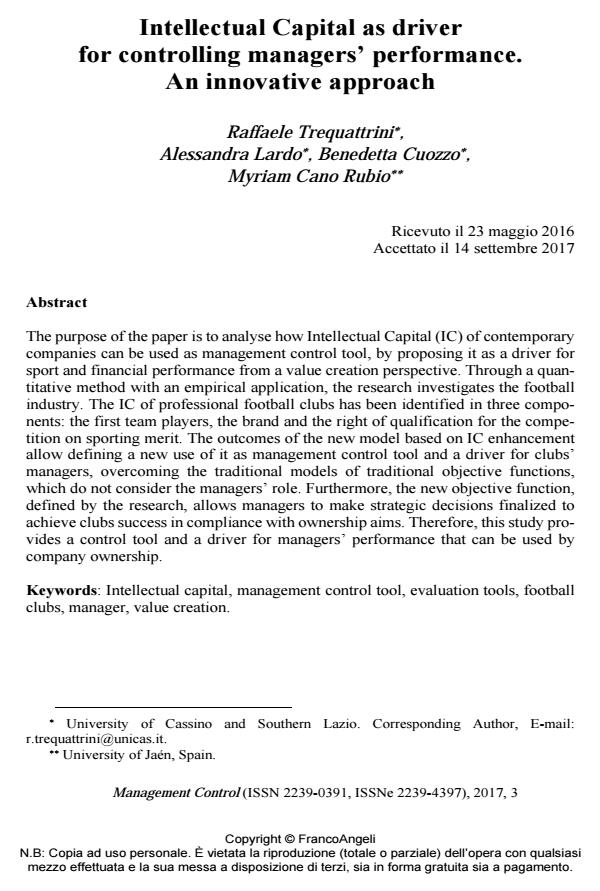Intellectual Capital as driver for controlling managers’ performance. An innovative approach
Titolo Rivista MANAGEMENT CONTROL
Autori/Curatori Raffaele Trequattrini, Alessandra Lardo, Benedetta Cuozzo, Myriam Cano Rubio
Anno di pubblicazione 2017 Fascicolo 2017/3
Lingua Inglese Numero pagine 20 P. 123-142 Dimensione file 267 KB
DOI 10.3280/MACO2017-003008
Il DOI è il codice a barre della proprietà intellettuale: per saperne di più
clicca qui
Qui sotto puoi vedere in anteprima la prima pagina di questo articolo.
Se questo articolo ti interessa, lo puoi acquistare (e scaricare in formato pdf) seguendo le facili indicazioni per acquistare il download credit. Acquista Download Credits per scaricare questo Articolo in formato PDF

FrancoAngeli è membro della Publishers International Linking Association, Inc (PILA)associazione indipendente e non profit per facilitare (attraverso i servizi tecnologici implementati da CrossRef.org) l’accesso degli studiosi ai contenuti digitali nelle pubblicazioni professionali e scientifiche
The purpose of the paper is to analyse how Intellectual Capital (IC) of contemporary companies can be used as management control tool, by proposing it as a driver for sport and financial performance from a value creation perspective. Through a quantitative method with an empirical application, the research investigates the football industry. The IC of professional football clubs has been identified in three components: the first team players, the brand and the right of qualification for the competition on sporting merit. The outcomes of the new model based on IC enhancement allow defining a new use of it as management control tool and a driver for clubs’ managers, overcoming the traditional models of traditional objective functions, which do not consider the managers’ role. Furthermore, the new objective function, defined by the research, allows managers to make strategic decisions finalized to achieve clubs success in compliance with ownership aims. Therefore, this study provides a control tool and a driver for managers’ performance that can be used by company ownership.
Parole chiave:Intellectual capital, management control tool, evaluation tools, football clubs, manager, value creation.
- The Going-Concern-Principle in Non-Financial Disclosure Rosa Lombardi, pp.1 (ISBN:978-3-030-81126-6)
- Il cambiamento dei sistemi di controllo manageriale e il processo di successione nelle imprese familiari. Quali possibili relazioni? Francesca Maria Cesaroni, Annalisa Sentuti, in MANAGEMENT CONTROL 1/2019 pp.17
DOI: 10.3280/MACO2019-001002 - The strength of weak rings: Teams performance measurement and management in sport Raffaele Trequattrini, Alessandra Lardo, Benedetta Cuozzo, Alberto Manzari, Pavlo Brin, in MANAGEMENT CONTROL 3/2021 pp.135
DOI: 10.3280/MACO2021-003007 - Intellectual Capital, Smart Technologies and Digitalization Raffaele Trequattrini, Fabio Nappo, Benedetta Cuozzo, Alberto Manzari, pp.93 (ISBN:978-3-030-80736-8)
- Managing complexity by business networks: the case of multi-club ownership in professional football Raffaele Trequattrini, Marco Lacchini, Maria Teresa Bianchi, Maria Schimperna, in Management Decision /2025
DOI: 10.1108/MD-12-2023-2438 - The profitable relationship among corporate social responsibility and human resource management: A new sustainable key factor Rosa Lombardi, Simone Manfredi, Benedetta Cuozzo, Matteo Palmaccio, in Corporate Social Responsibility and Environmental Management /2020 pp.2657
DOI: 10.1002/csr.1990 - The impact of digitalisation on professional football clubs Fabio Nappo, Alessandra Lardo, Maria Teresa Bianchi, Federico Schimperna, in MANAGEMENT CONTROL 2/2023 pp.117
DOI: 10.3280/MACO2023-002006 - The Going-Concern-Principle in Non-Financial Disclosure Rosa Lombardi, pp.31 (ISBN:978-3-030-81126-6)
Raffaele Trequattrini, Alessandra Lardo, Benedetta Cuozzo, Myriam Cano Rubio, Intellectual Capital as driver for controlling managers’ performance. An innovative approach in "MANAGEMENT CONTROL" 3/2017, pp 123-142, DOI: 10.3280/MACO2017-003008